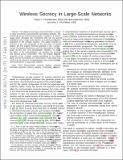Wireless secrecy in large-scale networks
Author(s)
Pinto, Pedro C.; Barros, Joao; Win, Moe Z.
DownloadWin_Wireless secrecy.pdf (270.0Kb)
OPEN_ACCESS_POLICY
Open Access Policy
Creative Commons Attribution-Noncommercial-Share Alike
Terms of use
Metadata
Show full item recordAbstract
The ability to exchange secret information is critical to many commercial, governmental, and military networks. The intrinsically secure communications graph (iS-graph) is a random graph which describes the connections that can be securely established over a large-scale network, by exploiting the physical properties of the wireless medium. This paper provides an overview of the main properties of this new class of random graphs. We first analyze the local properties of the iS-graph, namely the degree distributions and their dependence on fading, target secrecy rate, and eavesdropper collusion. To mitigate the effect of the eavesdroppers, we propose two techniques that improve secure connectivity. Then, we analyze the global properties of the iS-graph, namely percolation on the infinite plane, and full connectivity on a finite region. These results help clarify how the presence of eavesdroppers can compromise secure communication in a large-scale network.
Date issued
2011-02Department
Massachusetts Institute of Technology. Department of Aeronautics and AstronauticsJournal
2011 Information Theory and Applications Workshop
Publisher
Institute of Electrical and Electronics Engineers (IEEE)
Citation
Pinto, Pedro C., Joao Barros, and Moe Z. Win. “Wireless secrecy in large-scale networks.” In 2011 Information Theory and Applications Workshop, 1-10. Institute of Electrical and Electronics Engineers, 2011.
Version: Author's final manuscript
ISBN
978-1-4577-0360-7